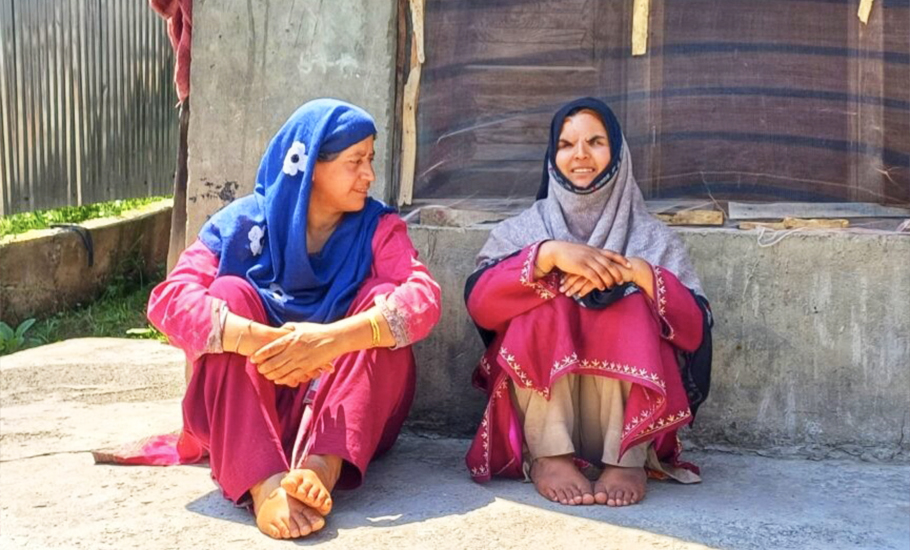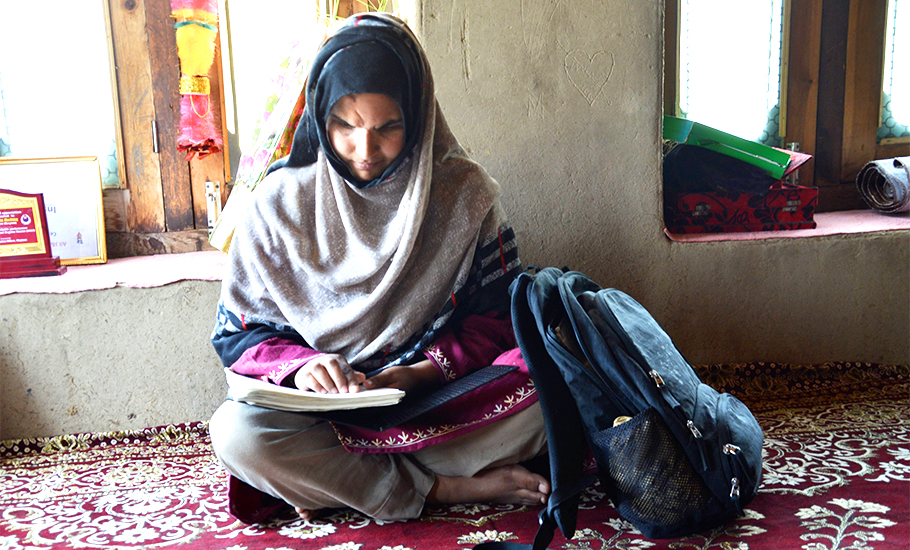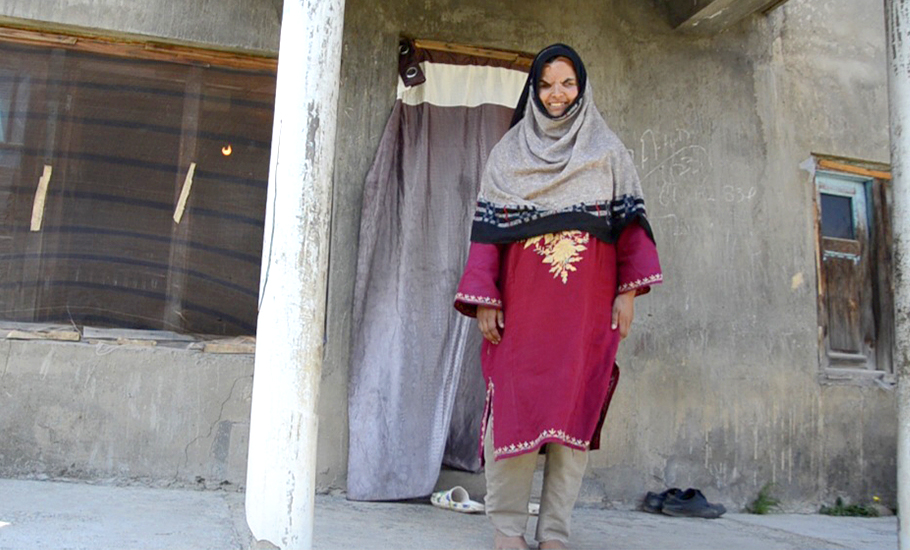
- Home
- News
- Analysis
- States
- Perspective
- Videos
- Education
- Entertainment
- Elections
- World Cup 2023
- Features
- Health
- Business
- Series
- Economy Series
- Earth Day
- Kashmir’s Frozen Turbulence
- India@75
- The legend of Ramjanmabhoomi
- Liberalisation@30
- How to tame a dragon
- Celebrating biodiversity
- Farm Matters
- 50 days of solitude
- Bringing Migrants Home
- Budget 2020
- Jharkhand Votes
- The Federal Investigates
- The Federal Impact
- Vanishing Sand
- Gandhi @ 150
- Andhra Today
- Field report
- Operation Gulmarg
- Pandemic @1 Mn in India
- The Federal Year-End
- The Zero Year
- Premium
- Science
- Brand studio
- Home
- NewsNews
- Analysis
- StatesStates
- PerspectivePerspective
- VideosVideos
- Entertainment
- ElectionsElections
- Sports
- Loading...
Sports - Features
- BusinessBusiness
- Premium
- Loading...
Premium

Blinded by pellet guns, how young Insha Mushtaq managed to see the big picture

On July 11, 2016, barely three days after Hizbul Mujahideen commander Burhan Wani was killed in a gunbattle with security forces in Kashmir, 14-year-old Insha Mushtaq was busy in her daily chores, arranging her schoolbooks while chatting with her cousins, when the silence of her village Sedow, enveloped by majestic pine trees and popular for its bountiful yield of potatoes, was suddenly broken...
On July 11, 2016, barely three days after Hizbul Mujahideen commander Burhan Wani was killed in a gunbattle with security forces in Kashmir, 14-year-old Insha Mushtaq was busy in her daily chores, arranging her schoolbooks while chatting with her cousins, when the silence of her village Sedow, enveloped by majestic pine trees and popular for its bountiful yield of potatoes, was suddenly broken by what appeared to be a din.
The children knew their village was tense since the news of Wani’s killing had trickled in.
So, upon hearing the commotion outside, driven by inquisitiveness, Insha walked up to the window of her house in Kashmir’s southern district of Shopian. As she got closer to the window, the din began to clear out. The sounds were that of protest slogans and gunshots. Insha slowly opened the window to see where the slogans and sound of gunshots were coming from. What Insha did not know was that this would be the last time she would see from her window or anywhere else.
She had barely stood by the window for 30 seconds watching Jammu and Kashmir Police personnel rain a barrage of iron pellets in all directions to disperse the crowd of villagers who were raising slogans in support of Wani, when the pellets hit her. Darkness descended upon her world as the pellets pierced through her face, skull, and most devastatingly, her eyes. Before Insha even knew what had happened to her, she had fallen to the ground in a pool of her own blood.
Cut to June 9, 2023, and Insha, now a 21-year-old woman, couldn’t stop smiling as friends and relatives gathered to congratulate her for securing 367 marks out of 500 (73.4%) in the J&K Board Class 12 examination.
Recalling the day she was blinded by the spiral of violence, which has come to define the Valley for over three decades now, Insha says, “I merely looked through the window when the policemen outside mercilessly fired from their pellet guns at me. I collapsed, and from thereon, everything faded into an abyss of darkness.”
Eight years on and countless surgeries later, Insha has emerged as a beacon of hope for those battling adversities.
The descent of darkness
The 2016 incident not only shattered Insha’s life but also the hearts of her family members. Her 50-year-old mother Afroza Bano vividly remembers the harrowing scene that unfolded before her eyes that day.
“I can never forget the sight of her blood-soaked face, the shattered window panes strewn across the floor,” Afrooza tells The Federal.

“When I caught sight of Insha, her face was drenched in blood. It felt as if an earthquake had struck us, leaving everyone frozen in disbelief. Desperate, I used my headscarf to gently wipe away the blood from my daughter’s face. We screamed for help, but at that very moment, the electricity failed, plunging us into darkness,” Afroza painfully recalls.
The family rushed Insha to the district hospital in Shopian.
Insha says she has a faint memory of being taken to the hospital. “Up to Shopian district hospital, I could hear my family members. But I could not speak even a word no matter how hard I tried.”
Realising the severity of her injuries, the doctors immediately referred Insha to Srinagar’s Sheri Maharaja Hari Singh (SMHS) Hospital. On way to Srinagar, Insha bled profusely. The pellets had caused multiple injuries, making it difficult for the doctors to stem the flow of blood.
All this while nobody knew what had struck Insha and caused the bleeding.
Overwhelmed by the situation, Afroza says, “It took us a torturous two hours to reach the hospital in Srinagar where we heard of pellets for the first time. She was in a coma for the next four days. Once she came out of coma, we realised that she will never be able to see again.”
In July 2016, Insha’s story sparked widespread outrage in the Valley forcing the Peoples’ Democratic Party (PDP) to intervene. Ex-chief minister Mehbooba Mufti made a promise to provide all necessary assistance. After spending a month at SMHS Hospital, Insha was referred to the All India Institute of Medical Sciences (AIIMS) in New Delhi. She remained at AIIMS for approximately two months, during which Mufti paid her a visit.
It was at AIIMS that Insha got to know about the loss of her vision when she overheard her father speak to someone about her condition. Insha, who had been bravely fighting the pain till then, broke down upon knowing that she will never be able to see again.
But Insha hadn’t just lost her eyesight. The pellets had pierced through her skull to the point that she virtually had no forehead. “The doctors at AIIMS had to perform four surgeries to repair my forehead,” Insha says pointing to the scars that remain as a grim reminder of what she had to face as a girl.
On September 13, 2016, Insha was taken to Aditya Jyoti Eye Hospital in Mumbai, where she received treatment from Dr S Natrajan for about a month. Dr Natrajan, who held positions as the Director of Aditya Jyoti Mumbai and the President of the Ocular Trauma Society of India, paid multiple visits to Kashmir in 2016 to perform eye surgeries on more than 200 victims of pellet guns.
Insha and her family later moved from Mumbai to Delhi for further evaluation at AIIMS before finally returning home in early October.
As she had become a symbol of the Kashmiri protests that year, many Kashmiri students studying in various universities came to meet her and express solidarity in the hospitals where she was being treated. Insha found strength in the support and began to see them as friends.
Upon returning home, however, they appeared to have forgotten about her, leaving her emotionally wounded. “Now, my mother is my only friend. She means everything to me,” Insha says.
The ‘non-lethal’ gun
Since 2017, Insha has been regularly visiting SMHS Hospital for check-ups, as there are still numerous pellets embedded in her body. Additionally, she has been receiving treatment at Sharp Sight Eye, a private hospital in Barzulla, for the past two years.
According to Kashmir’s health department, approximately 10,000 people sustained injuries during the protests in the wake of Burhan Wani’s killing. Out of the 10,000 injured, 6,205 protesters were struck by pellets, with 1,100 individuals suffering pellet injuries specifically in their eyes. A majority of those hit in the eyes lost their vision permanently.
Security forces claim the pellet-firing shotgun is used because it is categorised as ‘non-lethal’ and intended to disperse crowds. However, these ‘non-lethal’ guns have wrecked devastating injuries on hundreds of teenagers. The use of these shotguns, which expel a large number of iron pellets capable of penetrating the skin at high velocities, has been strongly criticised by human rights organisations.
In September 2017, Amnesty International published a comprehensive report titled ‘Losing Sight in Kashmir: The Impact of Pellet-Firing Shotguns’, which extensively documented 88 cases involving victims, predominantly teenagers and young adults, who sustained severe eye injuries during the 2016 uprising.
The report also reveals that over 1,200 persons were hit by pellets in their eyes during the summer 2016 uprising which left them partially or completely blind. Nearly 14 per cent of the pellet victims were below the age of 15.
Amnesty International India has said pellet guns carry an elevated risk of causing profound and irreversible harm to their targets as well as to bystanders. Controlling these risks effectively is virtually impossible.
Insha’s grit and people’s kindness
Despite losing vision, in 2018, Insha successfully completed her matriculation exams. She relied on the assistance of a helper who would verbally read out the question papers to her, and she would dictate her answers for the helper to transcribe.

Mushtaq Ahmad Lone, Insha’s father, employed as a driver at the state-run Motor Garages Department, revealed that when his daughter was preparing for her matriculation exams, she meticulously recorded the lessons a home tutor gave her and subsequently revisited the recordings to enhance her memorisation and retention abilities.
“Prior to July 2016, Insha’s routine after returning home from school entailed completing her homework before enjoying playtime with her cousin sisters. However, everything changed on July 11,” her father tells The Federal.
But Insha was determined to not give up.
After completing Class 10 in 2018, Insha enrolled at Delhi Public School, Srinagar to pursue braille education, a writing system used by individuals with visual impairments. Her admission to the school was made possible through Nadir Ali, who is the chairperson of the Centre for Peace and Justice (CPJ), an NGO. Nadir had concerns about funding Insha’s education and thought that no one would come forward to support her financially.
However, he was pleasantly surprised when he received a call from Ragu Raman, a philanthropist and advocate for accessible education. Impressed by Insha’s interviews, Ragu Raman offered to take care of her admission, bringing relief to Nadir Ali.
Consequently, Nadir Ali’s office at Rajbagh became a temporary residence for Insha, and CPJ arranged a two-room set near their office for Insha and her younger brother, Nafee, to stay.
Ali lamented the fact that while many people were aware of Insha’s story, very few approached him with concrete suggestions on how to support her financially. In the past five years, no one had come forward with offers of financial assistance. One day in 2018 Ali received a call from Insha, expressing her intention to continue her education. This posed a real challenge for Ali, as he needed to find a suitable educational institution for her to learn braille and facilitate her usage of a phone and independent mobility.
Ali approached DPS, Srinagar, which had a dedicated braille education department.
However, the financial hurdle remained. It was then that Ragu Raman stepped in and generously covered Insha’s fees, and rent for a two-room house in Srinagar.
Ali, on his part, not only took care of Insha’s education but under the programme ‘Beyond Victimhood and Education’, he ensured the rehabilitation of 35 pellet victims.
With the financial problems settled, the true challenge lay in providing Insha with necessary education.
“Nadir sir supported me. He admitted me to Delhi Public School, Srinagar, where I learnt braille and other subjects important for visually impaired people. Later, Nadir sir with the help of Raman sir ensured I get accommodation in Srinagar. He also arranged two teachers who came for home tuition,” she said.
At CPJ, Insha found a guide in Sharika Zargar, an employee of the organisation.
Sharika persistently guided and encouraged Insha in her academic endeavours. Gradually, Insha began to accept her new reality and this brought her solace.
With the help of Sharika and many others, Insha independently manages to her household chores, including cooking, extending gracious hospitality to her guests. She has surrounded her house with books and keeps them as well arranged as her house is orderly.
Insha aspires to be an IAS officer and work for the visually-impaired people but what she finds painful is the vitriol people still subject her to.
“Certain individuals offer solace to me. But others exhibit rudeness and accuse me of being an opportunist. They engage in gossip about me. There are also those who confront me directly, accusing me of receiving government assistance. I’m shocked by their callousness,” Insha says.
But what hurts her the most is the fact that she is unable to see her parents and siblings.
“I miss my parents. I miss seeing them. I yearn to see my two younger brothers growing.”

“At times, I desire to see my own reflection. I am aware that my face was distorted due to the pellets.”
Dr Shaziya Shafi, an ophthalmologist from Kashmir who has been treating Insha since the last four years says, “Unfortunately, Insha will not regain her vision ever. Her blindness is permanent, and there is no known way to restore her sight anywhere in the world. Our focus now is on visual rehabilitation, and Nadir Ali, is doing an exceptional job in that regard. Insha’s eyes have undergone multiple surgeries, leading them to the stage of phthisis, which can cause pain and potential infections. It is heartbreaking to accept that she will never be able to see again.”

